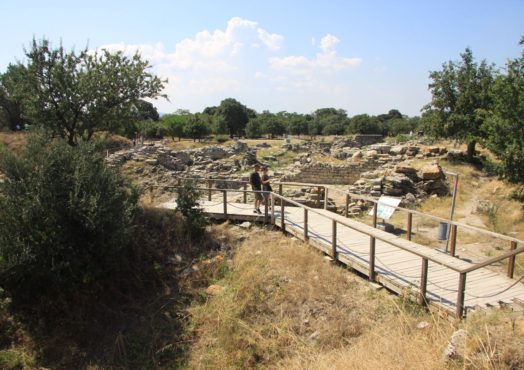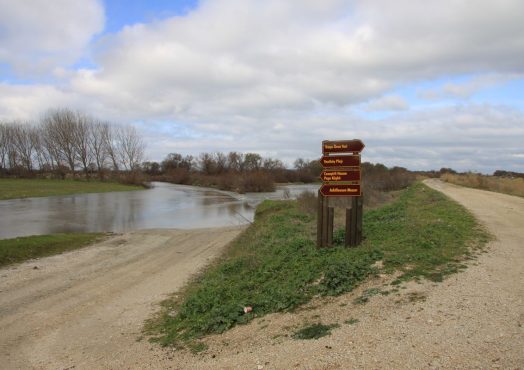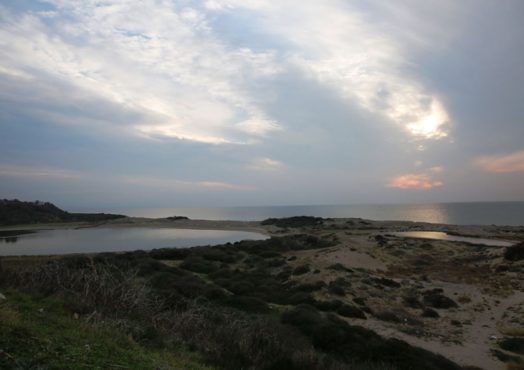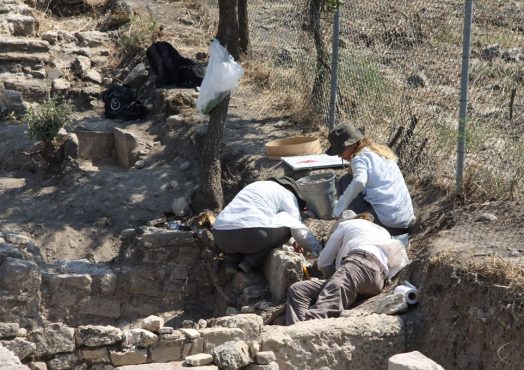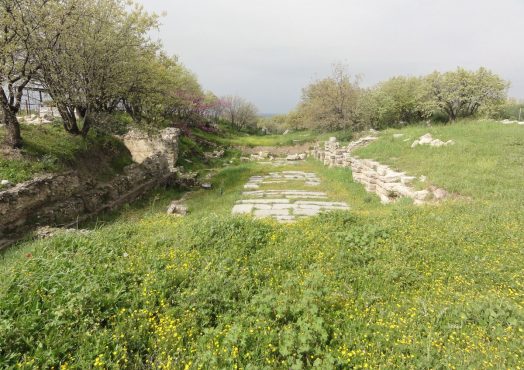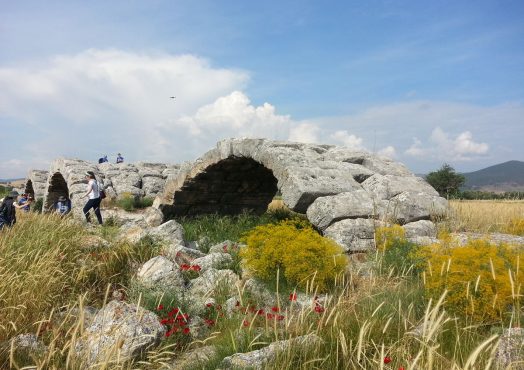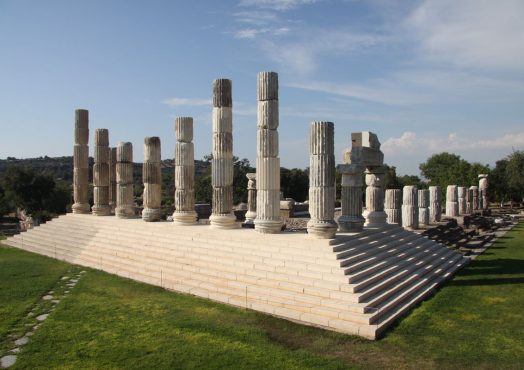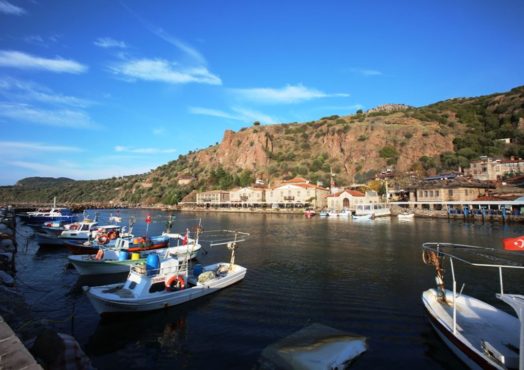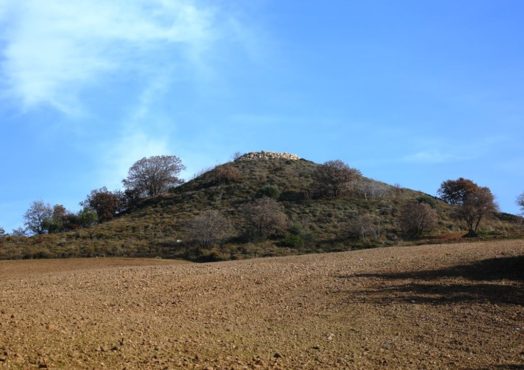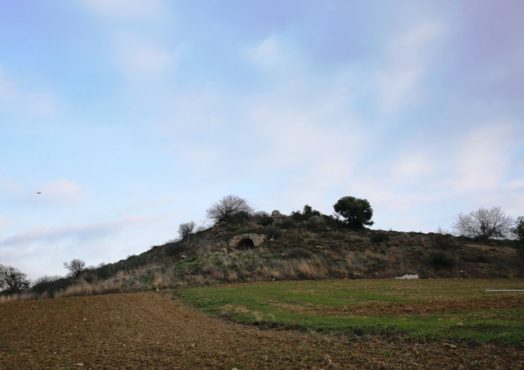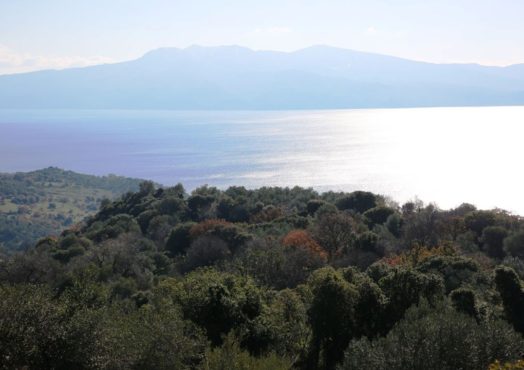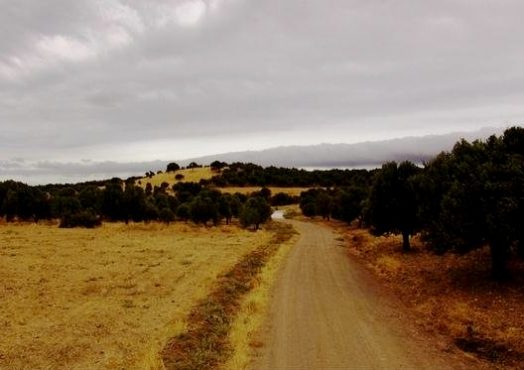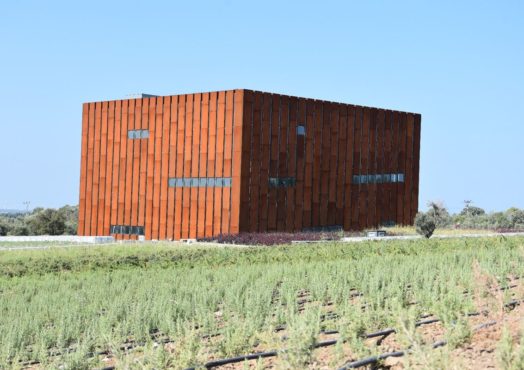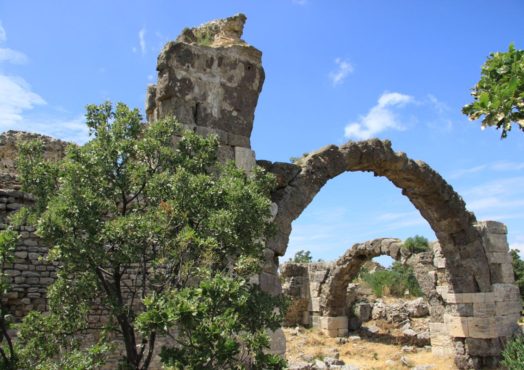Troy
Troy is situated 25 km southwest of Çanakkale, adjacent to the Tevfikiye village. According to archaelogical findings, the first settlements here began around 3000 BC. Troy was inhabited until 350-400 BC and presently it is a tumulus that consists of ten layers of different settlements. Troy was populated for thousands of years due to its strategic location, got wealthy and prospered with sea trade and witnessed many wars and devastations. Yet it remained an important city throughout history, from ancient times to the present day.
In addition to its historical value, Troy was also made famous by Homer’s epic the Iliad. In fact, Troy name has become almost synonymous with Homer and the Iliad. The Iliad and the Odysseus are acknowledged as the first literary works of the western civilisation. Troy was added to the UNESCO World Heritage List in 1998. The ongoing excavations are led by the Director of Excavations, Prof. Dr. Rüstem Aslan. The 12 km radius around Troy including the starting points of the Troy Culture Route, was declared a National Historical Park in 1996 and became a conservation area.
Karamenderes (Scamandros)
The Karamenderes river is formed by smaller streams that collect the rain and melted ice waters from the Ida Mountains. It forms a delta on the Anatolian side of the Bosporus and then opens up into the Aegean. It is possible to see here many of the animal and plant species mentioned in Homer’s epic novels. It is known that part of the war told in the Iliad took place in today’s Beşik Bay, the Antique Harbour of Troy near Yeniköy. Research shows that Troy was in fact adjacent to the sea 5000 years ago. Over the centuries, the overflowing of Karamederes and Dümrek rivers filled up the shoreline and eventually Troy lost its characteristic as a natural harbour.
Antique Harbour (Dalyan)
Dalyan Antique Harbour- One of the most interesting things about Dalyan is its crimson lake with its almost foamy seashore. The warm water’s high salt concentration createsa prime breeding ground for Dunaliella algae salina which turns the water into its red colour. You can see the lake as you climb over the small hill to the south of the harbour. This is in fact the harbour of the antique city of Alexandria Troas; it has turned into a lake after the sea filled over time. You can see some of the granite columns in the sea and around the lake to this day. In the past, gigantic granite pillars were extracted from the stone quarries in Antique Neandria, carried down to this harbour by sliding them over rolling tree logs and sent by ships to the important cities around the world, such as the Palmyra Antique City in Syria, Rome and Vatican City.These granite pillars were used as columns and stepping stones when building monuments, temples and tombs. You can see some of these pillars in the antique quarry near Yahya Çavuş village, around the antique harbour in the sea. It is still astounding to this day to think how these pillars were produced and transported two thousand years ago.
St Paul, one of the important figures of the Christian world set out to European soils for the first time from this harbour on his second missionary journey. On his third journey he came to this harbour once again and stayed in Alexadria Troas for a week. You can take a small expedition around the antique harbour, have a picnic, go for a swim near the ancient pillars and watch the sunset if the time allows.
Alexandria Troas
The city was suggested to be the capital of the Roman Empire during the Caesar and Constantine periods. Due to the fact that its stone were carried to Istanbul and used in many public buildings, it is also called the “Old Istanbul”. Alexandria Troas was founded by Antigonos, one of the commanders of Alexander the Great in 310 BC and is located 1.5 km to the southeast of the antique harbour. Initially, the smaller settlements around such as Gargara, Hamaxitus, Cebrene, Kolonai, Larissa, Neandria and Skepsis were administered by Alexandria Troas. However, in time, all of these cities were emptied, and the populations were transferred to Alexandria Troas in order to bring together other small and vulnerable cities. It is estimated that in this way the population of the city rose up to 100,000.
Antique Roman Way
In Roman times, Troas region had roads interconnecting antique cities and bridges connecting all of these roads together. The 35 km sacred road between Alexandria Troas and Apollo Smintheion hadgreat importance in ancient times both functionally and spiritually. During religious ceremonies held in the name of the God Apollo, the public would walk this ceremonial route from Alexandria Troas together with sacrificial animals and gifts. The beginning sections of the sacred road from either end have been unearthed during the Apollo Smintheion and Alexandria Troas excavations. The Apollo Smintheion section is 7.2m wide and so far about 45m of the road has been unearthed. It is possible to walk on the actual road today but some sections of it remain under the current motorway.
Roman Bridge
Part of the sacred road is the Roman Bridge within the borders of the Tuzla Plain. The bridge is thought to have been built in the 2nd century AD. It is built in block stones and 93m of it is visible to the eye. Arch abutments are 7m high, 3-4m of which are buried under the ground. The bridge is left in the midst of fields today as the riverbed has changed over the course of time creating an interesting and picturesque view. There are no signs of the bridge being used by vehicles of the antique period and the architectural details hint that it could be a religious throughfare occasionally used by visitors from Alexandria Troas travelling for Apollo’s prophecies.
Apollo Smintheus (Smintheion)
Apollo Smintheion Sacred Court is located in the water-rich Bahçeleriçi locality of Gülpınar. During the excavations in the Sacred Court (Smintheion) a prehistoric settlement dated to 5000 BC was identified. The Sacred Court has a unique character within the architectural history of Anatolia and it is thought that it was built in the mid 2nd century BC. Smintheion Sacred Court was an important cultic centre of the Troas region in the ancient ages. The first historical association of God Apollowith mice (sminthos) was made in the Troas region. We find out about the honoring of Apollo in the Troas region initially from Homer’s Iliad where he mentions “Apollo, Leto and Zeus’ son, whom the fine-haired Leto gave birth to” and from the events that took place as a result of Achilleus’ wrath. The damages created by harvest mice and the catastrophies that came with them play a big part in the creation of the Apollo myth. Apollo punished powerful kings with the black plague spread by mice for all the maltreatment against their people and this way helped restore justice. The excavations started in 1980 and are still continuing to this day by a team led by Prof. Dr. Coşkun Özgünel.
Assos
Assos was built on an andesite rock hill about 234m above sea level on the southern coast of the Troas Region. Although it is not clear who the first occupiers in Assos were, it is known that there were settlers starting from the First Bronze Age. According to archaelogical data, Aeolian migrants from the nearby Lesbos island started settling in Assos starting from the 7th century BC. Homer mentions in the Iliad that the Lelegians, who are a local community living in the south Troas region, are famous for their seamanship and their piracy.
The philosopher Aristotle lived in Assos between the years 347 BC and 345 BC, founded a philosophy school and gave lessons. St Paul also visited the city on his journey from Alexandria Troas (Dalyan) to Lesbos.
Assos today carries the name Behramkale-Behramköy and from 2000 BC to present day it has been continuously occupied as a settlement. In 1330 it came under the rule of the Ottoman Empire. Excavation work carried out by J.T. Clarke and F.H. Bacon from the American Institute of Archaeology in 1881 continued until 1883. After a hundred year gap, the excavations have been reestablished by Prof. Dr. Nurettin Arslan and his team in 2006. Among the ruins in Assos are the Athena Temple in the Acropolis, the Byzantium city walls, the Hüdavendigar Mosque, and the antique road. The ruins also contain two tombs that have been well-preserved since the Archaic period, the city walls, the Gymnasion, the Agora, the Stoa, the Bouleuterion, a theatre and a church. The most significant artefact of Assos is the Athena Temple built on the highest plain of the Acropolis in 530 BC. This structure is very important from an architectural point of view. It is the first and only Archaic Age Dorian architectural structure in Anatolia. It takes its name from Athena, Zeus’ daugther and one of the 12 Gods of Olympus. Athena is the guardian Goddess of the city.
Today, Assos is the most well-known touristic place of the region. Behramkale village stands out with its authentic architecture. There are plenty of B&Bs, boutique hotels, restaurants, cafes and souvenir shops in the village and antique harbour.
Achilleion (Beşik-Yassıtepe) and Achilleus’ Tumulus
The name Achilleion means “Achilleus’s Place”. The city is thought to have been founded by the migrants from Lesbos island. Prof. Dr. Manfred Osman Korfmann who was the head of Troy excavations for many years, unearthed an Archaic settlement and a necropol area and acknowledged the place as Achilleion. It is believed that Achilleion was destroyed as a result of the wars with the city of Sigeion 5km north, founded by the Athenians.
The excavations showed settlement traces dating back to 3000 BC (Troy I period), fallowed by Late Bronze Age (same as Trojan War period), Archaic, Byzantine and Ottoman periods. On the hill just at the back of the tumulus and that watches over Beşike Bay is located the Achilleus’ Tumulus.
Whilst you are at Achilleus’ Tumulus, you could have a rest, watch the beautiful scenery and have a swim at the Papaz Beach nearby depending on the season.
Aias Tumulus
It can be seen on the side of the path that descends to the plain to the north of Kumkale Village. Aias is one of the most prominent heros of the Trojan War as told in Homer’s Iliad. Aias, the great king of Salamis island joined the Trojan War to fight alongside with the Achaeans together with his 12 ships. He was the tallest man in the army and was well-built therefore he was known as the Great Aias. He was the second greatest warrior of the army after Achilleus. When Paris shot Achilleus in the heel and killed him, Aias managed to carry him on his back all the way to the Achaean ships despite the hail of arrows.
Coşkuntepe (Bademli)
As with the rest of Anatolia, the oldest settlements in Troas region are traced back to the Neolithic Age (8000-5500 BC) when people adopted a settled life and started farming and animal breeding. The most important Neolithic Age settlements in the region is Coşkuntepe, located on an elevated natural hill 4km towards the sea. Excavations have indicated there were settlers here around 6000 BC who made their living through fishing and animal breeding. Similar settlements are known to exist around the same period in theKaraağaçtepe and Hamaylıtarla localities on the Gallipoli Peninsula and in Uğurlu/Zeytinli in Gökçeada.
Hanaytepe (Bozköy)
Bozköy-Hanaytepe is one of the prehistoric plain settlements in Troas region. This tumulus that is located in Bozköy town limits and near the Tepealtı River, is one of the most important settlement areas of the region. Prof. Dr. Rüstem Aslan, who carried out the surface explorations on the tumulus, states that Bozköy Hanaytepe is one of the most important settlements of the Bronze Age and earlier periods and is in fact the biggest tumulus after Troy. Very high quality stone-headed hand axes from 5000 years ago made of different types of stones have been found.
Troy Museum
The museum is situated at the entrance of the Ancient City of Troy. It has 11,200 square metres of total indoor area of which 3,000 square metres is the exhibition space. Museum’s exhibit starts as you walk down the ramp. The alcoves along the ramp contain tomb stones, large sculptures, animations and oversized photographs that depict the various layers of Troy. The museum presents Troy City’s excavation layers, the excavation history and the findings from Troas region, aided by interactive elements. The Treasures of Troy gold section, Roman sculptures and Polyxena Sarcophagus are some of the prominent artefacts in the museum. The open terrace at the top floor offers magnificent views of the land of Homer and the Dardanelles. You can also appreciate the stunning panorama of Troy National Historical Park and the Culture Route from here.
Atticus Baths
The city went through its biggest development phase during Emperor Hadrian (117-128). Hadrian built expansive structures in the city. Aquaducts bringing water from the Ida Mountains that were built with the contributions of wealthy Athenian, Herodes Atticus and the public baths are interesting examples of water architecture. The baths, 84m by 123m in size, were built in 135 and they are the largest of the period making it into the “top list” of Roman Empire structures. For a long period, the 17th century travellers mistook and visited it as the ancient city of Troy. The Alexandria Troas excavations are currently carried out by a team led by Ass. Prof. Erhan Öztepe.

